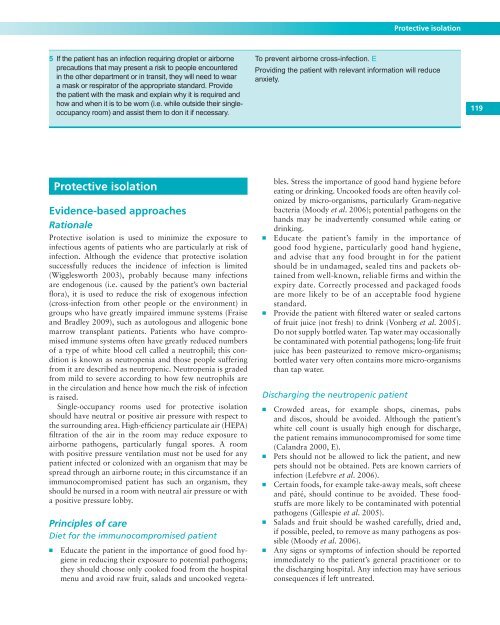Infection prevention and control - Royal Marsden Manual of Clinical ...
Infection prevention and control - Royal Marsden Manual of Clinical ...
Infection prevention and control - Royal Marsden Manual of Clinical ...
You also want an ePaper? Increase the reach of your titles
YUMPU automatically turns print PDFs into web optimized ePapers that Google loves.
5 If the patient has an infection requiring droplet or airborne<br />
precautions that may present a risk to people encountered<br />
in the other department or in transit, they will need to wear<br />
a mask or respirator <strong>of</strong> the appropriate st<strong>and</strong>ard. Provide<br />
the patient with the mask <strong>and</strong> explain why it is required <strong>and</strong><br />
how <strong>and</strong> when it is to be worn (i.e. while outside their singleoccupancy<br />
room) <strong>and</strong> assist them to don it if necessary.<br />
Protective isolation<br />
Evidence-based approaches<br />
Rationale<br />
Protective isolation is used to minimize the exposure to<br />
infectious agents <strong>of</strong> patients who are particularly at risk <strong>of</strong><br />
infection. Although the evidence that protective isolation<br />
successfully reduces the incidence <strong>of</strong> infection is limited<br />
( Wigglesworth 2003 ), probably because many infections<br />
are endogenous (i.e. caused by the patient’s own bacterial<br />
fl ora), it is used to reduce the risk <strong>of</strong> exogenous infection<br />
(cross-infection from other people or the environment) in<br />
groups who have greatly impaired immune systems ( Fraise<br />
<strong>and</strong> Bradley 2009 ), such as autologous <strong>and</strong> allogenic bone<br />
marrow transplant patients. Patients who have compromised<br />
immune systems <strong>of</strong>ten have greatly reduced numbers<br />
<strong>of</strong> a type <strong>of</strong> white blood cell called a neutrophil; this condition<br />
is known as neutropenia <strong>and</strong> those people suffering<br />
from it are described as neutropenic. Neutropenia is graded<br />
from mild to severe according to how few neutrophils are<br />
in the circulation <strong>and</strong> hence how much the risk <strong>of</strong> infection<br />
is raised.<br />
Single-occupancy rooms used for protective isolation<br />
should have neutral or positive air pressure with respect to<br />
the surrounding area. High-effi ciency particulate air (HEPA)<br />
fi ltration <strong>of</strong> the air in the room may reduce exposure to<br />
airborne pathogens, particularly fungal spores. A room<br />
with positive pressure ventilation must not be used for any<br />
patient infected or colonized with an organism that may be<br />
spread through an airborne route; in this circumstance if an<br />
immunocompromised patient has such an organism, they<br />
should be nursed in a room with neutral air pressure or with<br />
a positive pressure lobby.<br />
Principles <strong>of</strong> care<br />
Diet for the immunocompromised patient<br />
■ Educate the patient in the importance <strong>of</strong> good food hygiene<br />
in reducing their exposure to potential pathogens;<br />
they should choose only cooked food from the hospital<br />
menu <strong>and</strong> avoid raw fruit, salads <strong>and</strong> uncooked vegeta-<br />
Protective isolation<br />
To prevent airborne cross-infection. E<br />
Providing the patient with relevant information will reduce<br />
anxiety.<br />
bles. Stress the importance <strong>of</strong> good h<strong>and</strong> hygiene before<br />
eating or drinking. Uncooked foods are <strong>of</strong>ten heavily colonized<br />
by micro-organisms, particularly Gram-negative<br />
bacteria ( Moody et al . 2006 ); potential pathogens on the<br />
h<strong>and</strong>s may be inadvertently consumed while eating or<br />
drinking.<br />
■ Educate the patient’s family in the importance <strong>of</strong><br />
good food hygiene, particularly good h<strong>and</strong> hygiene,<br />
<strong>and</strong> advise that any food brought in for the patient<br />
should be in undamaged, sealed tins <strong>and</strong> packets obtained<br />
from well-known, reliable firms <strong>and</strong> within the<br />
expiry date. Correctly processed <strong>and</strong> packaged foods<br />
are more likely to be <strong>of</strong> an acceptable food hygiene<br />
st<strong>and</strong>ard.<br />
■ Provide the patient with fi ltered water or sealed cartons<br />
<strong>of</strong> fruit juice (not fresh) to drink ( Vonberg et al. 2005 ).<br />
Do not supply bottled water. Tap water may occasionally<br />
be contaminated with potential pathogens; long-life fruit<br />
juice has been pasteurized to remove micro-organisms;<br />
bottled water very <strong>of</strong>ten contains more micro-organisms<br />
than tap water.<br />
Discharging the neutropenic patient<br />
■ Crowded areas, for example shops, cinemas, pubs<br />
<strong>and</strong> discos, should be avoided. Although the patient’s<br />
white cell count is usually high enough for discharge,<br />
the patient remains immunocompromised for some time<br />
( Cal<strong>and</strong>ra 2000 , E ).<br />
■ Pets should not be allowed to lick the patient, <strong>and</strong> new<br />
pets should not be obtained. Pets are known carriers <strong>of</strong><br />
infection ( Lefebvre et al . 2006 ).<br />
■ Certain foods, for example take-away meals, s<strong>of</strong>t cheese<br />
<strong>and</strong> pâté, should continue to be avoided. These foodstuffs<br />
are more likely to be contaminated with potential<br />
pathogens ( Gillespie et al . 2005 ).<br />
■ Salads <strong>and</strong> fruit should be washed carefully, dried <strong>and</strong>,<br />
if possible, peeled, to remove as many pathogens as possible<br />
( Moody et al . 2006 ).<br />
■ Any signs or symptoms <strong>of</strong> infection should be reported<br />
immediately to the patient’s general practitioner or to<br />
the discharging hospital. Any infection may have serious<br />
consequences if left untreated.<br />
119


